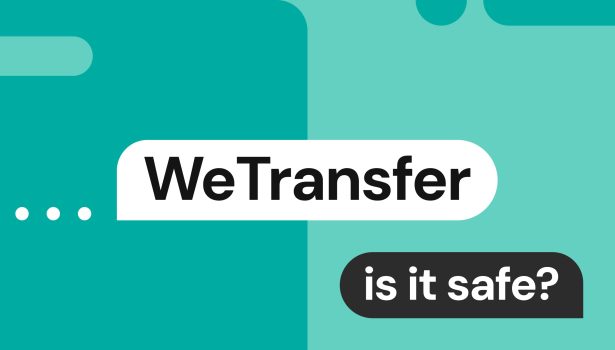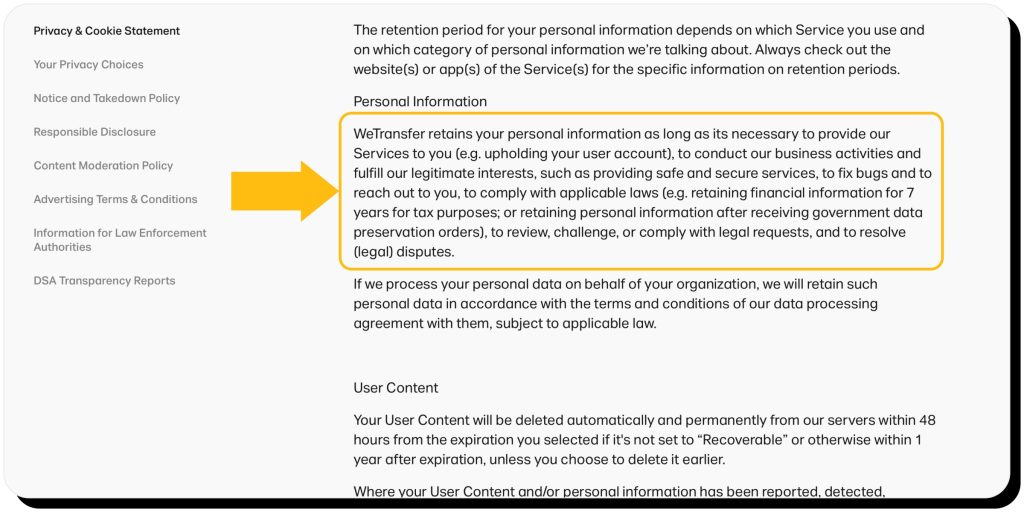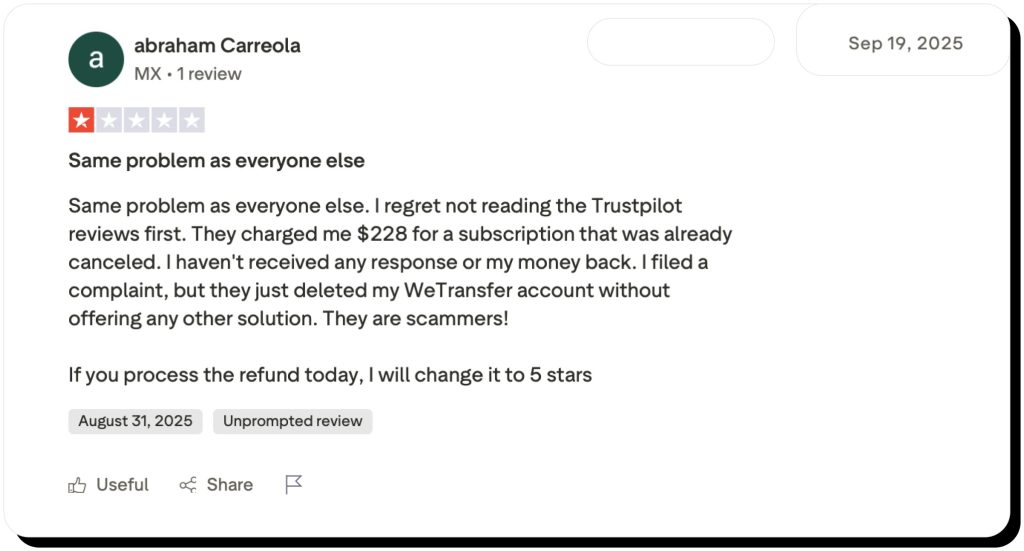Is WeTransfer safe? A 2025 guide to security measures and risks

WeTransfer is generally considered safe for everyday file transfers: it implements advanced encryption measures, offers two-factor authentication, and allows users to set passwords to access files.
However, it’s not the best choice for sending sensitive info as files aren’t end-to-end encrypted, meaning they can theoretically be accessed by WeTransfer staff under certain conditions like legal requests. Additionally, the platform is sometimes exploited by scammers launching phishing and impersonation attacks, so caution is necessary when receiving links.
Is WeTransfer legit?
WeTransfer is a legitimate file transfer platform used by millions of individuals, creative professionals, and businesses. The service allows sharing videos, photos, and documents in many file formats, including JPEG, MOV, WAV, and PDF.
Headquartered in Amsterdam, Netherlands, WeTransfer is owned by established technology company Bending Spoons. They currently partner with internationally recognized artists, entertainers, and brands, with projects featured at the Tribeca Film Festival and the Royal Academy of Arts.
Is WeTransfer secure?
WeTransfer is typically considered a safe file transfer tool if you avoid sharing sensitive information or intellectual property. For everyday transfers, the security protocol meets basic standards and follows respected security guidelines.
Encryption
WeTransfer uses two types of encryption methods to protect data during and after file transfers, making it difficult for hackers to intercept your information. These include:
- TLS encryption for data during transit, meaning while your files are uploaded/ downloaded.
- AES-256 encryption to protect files in storage (on WeTransfer’s servers).
Link expiration
The default expiration time is 3 days, after which the link stops working and files can’t be accessed. The expiration period can be shortened to 1 day or extended even to forever (though extending is available only on paid accounts).

Optional password protection
Previously available only on paid accounts, now password protection is available to free users as well. This feature allows creating a password that the receiver needs to enter to access the files. This ensures that even if the transfer link is intercepted, forwarded, or guessed, the files remain inaccessible without the correct code.
Two-factor authentication
Both free and premium accounts can enable two-factor authentication (2FA), which requires a second step to log in, beyond a password. This helps protect your account from unathorized access even if your password is breached. 2FA on WeTransfer is app-based (requires an authenticator app such as Microsoft Authenticator or Google Authenticator).
ISO 27001 Certification
This certification implies that WeTransfer meets an internationally recognized standard for Information Security Management Systems (ISMS). This means that the company follows a structured framework to protect sensitive data (including customer files) and has implemented risk assessment and mitigation processes to identify, monitor, and reduce security threats.
WeTransfer security limitations and common risks
There have been recent criticisms around WeTransfer, mainly regarding a lack of transparency around its terms and conditions. Though the platform is secure enough for casual transfers, there are limitations and concerns you should be aware of:
No end-to-end encryption
Lack of end-to-end encryption (E2EE) makes files accessible not only to senders and receivers, but to WeTransfer as well. This means that your data can potentially be accessed by employees upon legitimate needs like legal requests. Additionally, though the platform encrypts data in transit and on its servers, it’s still possible that a breach could happen and your files could get exposed.
Difficulty verifying the sender’s identity
To make a transfer, all you need is an email address—you don’t even really need to create an account. While this streamlines the process for ordinary users, it’s also a security vulnerability exploited by hackers. They can either break into the email accounts of your friends/ relatives/ associates or create similar-looking ones and send malicious files. To verify that a transfer is legit, you need to contact the sender directly and ask, you can’t just rely on the email.
Metadata collection
When you use WeTransfer, they collect the data your provide directly as well as the data about your device, usage patterns, inferred interests, and more. While it’s not uncommon for online services to aggregate this information, WeTransfer doesn’t provide specific retention periods. Instead, they claim to keep your data for “as long as necessary.” Moreover, WeTransfer shares user data with advertisers, marketers, and other third parties (beyond the ones necessary to fulfill the service), which ultimately reduces user privacy and increases exposure to targeted tracking.

Data breaches
In June of 2019, WeTransfer accidentally sent thousands of files to incorrect email addresses over the course of 2 days. While the company eventually blocked access to the links and provided some security advice, the fact remains that sensitive files were sent to the wrong people—potentially jeopardizing intellectual property rights and privacy for a number of WeTransfer users.
AI data training controversy
Recently, WeTransfer faced backlash after updates to its Terms of Service included vague language about how user files and data could be used. Some critics interpreted the new terms as granting the company rights broad enough to allow training AI models.This sparked concern among users, especially creative professionals, that their work might be repurposed without consent. WeTransfer quickly clarified that it does not use customer files to train AI systems and revised its wording, but the incident left some users wary about the platform’s privacy commitments.
User experience
WeTransfer has mixed reviews online, with many people experiencing issues with the platform’s paid subscriptions. Some users mention difficulty reaching customer service representatives and delays in refunding or canceling plans.

How to use WeTransfer safely
To make sure your files aren’t exposed to unathorized parties and you don’t accidentally fall victim to scammers, take the following steps:
Never share sensitive or valuable data
Any platform that doesn’t use E2EE puts you at some risk of property or identity theft in the event of data interception or breach. For sharing sensitive info, it’s better to use more secure platforms like Signal or Proton Drive.
Avoid sending private files over public Wi-Fi
Public Wi-Fi increases the risk of your data being intercepted by hackers. Without encryption at the network level, cybercriminals can monitor traffic, capture login credentials, or even inject malware into downloads. To protect your data, it’s safer to use a trusted, password-protected connection or add an extra layer of security with a VPN.
Verify email addresses
Verify that any files you receive are from an email address you recognize and one that you expect to receive files from. Most email clients allow you to hover your mouse over the “from” field to see the sender’s actual email address. If you don’t recognize the address, avoid opening any links.
Set up passwords for file transfers
This will make sure that only the intended recipient can access the files and helps prevent accidental exposure if you send a link to the wrong email address.
Set up 2FA
To prevent unauthorized access to your accounts (and, ultimately, your files), enable 2FA. You can do this by going to Account > Profile and Security, and then selecting Turn On for 2FA.
Check the site URL
If you plan to use WeTransfer, don’t automatically click on a website link sent to you via email, text, or found anywhere else online. Instead, go to the site directly and make sure the URL is https://wetransfer.com.

Set short expiration periods
Set short periods (1 or 3 days) so that your files don’t stay online for longer than necessary. This will reduce the window of opportunity for unauthorized access and limit the potential damage if a link is accidentally shared or intercepted.
Don’t download files sent from unknown accounts
Anytime you open a link from someone you don’t know, there is a risk of it being a malicious executable that can intercept your data or install malware on your device. If the sender is familiar but the transfer is unexpected, contact the person directly and ask if it’s legit.
Be wary of executable or compressed files
Executable (.exe, .bat, .scr) and compressed (.zip, .rar) files can be exploited to deliver and run malware on your devices. Once executed/ extracted, the malware can install spyware, ransomware, or keyloggers on your device, potentially leading to identity theft, stolen passwords, or full system compromise. Compressed files are especially risky because they can bundle multiple hidden files and bypass basic security scans.
Alternatives to WeTransfer
These days, there are many options to transfer files online. However, they all differ in security and reliability. Here are a few alternatives to WeTransfer worth noting:
Dropbox Transfer
Dropbox Transfer a better choice for teams and professional use, while WeTransfer is more convenient for casual, temporary file sharing. Dropbox Transfer is built on top of the Dropbox ecosystem, allowing users to send files directly from their cloud storage and retain copies even after transfer links expire. It also integrates with Google Workspace and Slack.
Google Drive/ OneDrive
With Google Drive, users can store files long-term, organize them into folders, and collaborate in real time using Docs, Sheets, and other Google Workspace apps. Files can be shared through permission-controlled links, giving senders the ability to restrict access and revoke it at any time. OneDrive is Microsoft’s integrated cloud storage and productivity platform, offering long-term storage, file syncing across devices, and deep integration with Microsoft 365 apps like Word, Excel, and Teams. Access can also be edited/ revoked at any time.
SwissTransfer
SwissTransfer is a free file-sharing tool based in Switzerland. The platform isn’t as collaborative as Google Drive or Dropbox Transfer, but it allows sending much larger files. You can send 50GB files daily, with up to 500 transfers. Like WeTransfer, SwissTransfer provides basic security measures like TLS, AES-256 encryption, and password protection, but it doesn’t use end-to-end encryption. While it benefits from Switzerland’s strong privacy laws, it may not be the best option for highly sensitive data.
Send Anywhere
Send Anywhere is a popular mobile-friendly file-sharing tool you can set up across devices. Users can upload larger files than on WeTransfer (up to 10GB per file). The platform has such security features as adding a unique 6-digit key system for device-to-device transfers, 48-hour expiration on shared links, and password protection by default.
How Onerep helps protect your data
To target you with phishing and social engineering attacks, scammers need to know at least your email and name. Unfortunately, this information is readily available to them online—on public data brokers AKA people-search sites. In addition to your name and contact details, these websites also reveal your home address, relatives, net worth, political affiliations, and much more.
Onerep protects your privacy by removing your personal data from 232 data brokers. The service finds all the pages that expose your private details, then sends opt-out requests on your behalf. By removing your information, Onerep protects you not only from phishing, but also from impersonation, identity theft, stalking, and other threats.
FAQs
Is WeTransfer encrypted?
Yes, WeTransfer encrypts files and data both in transit and at rest. They rely on TLS encryption when files are being transferred from sender to receiver, and AES 256 encryption while its store on WeTransfer’s servers. However, end-to-end encryption isn’t used, meaning WeTransfer has access to all encryption keys and may potentially access your files.
What is WeTransfer and is it safe?
WeTransfer is a file-sharing service that can be used on mobile or desktop devices. Users can share files up to 3GB by sending a link, even if the recipient doesn’t have an account. Overall, it’s relatively safe for casual use, but users may want to limit transferring important or sensitive files due to lack of E2EE.





Mark comes from a strong background in the identity theft protection and consumer credit world, having spent 4 years at Experian, including working on FreeCreditReport and ProtectMyID. He is frequently featured on various media outlets, including MarketWatch, Yahoo News, WTVC, CBS News, and others.